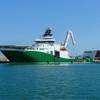Marine News Boat of the Month: October 2018
The Virginia-based pilots say that this Gladding Hearn-built workhorse checks all the boxes: safety, stability, reliability, service support, speed and efficiency.
This is not your grandfather’s pilot boat. The 55-foot Chesapeake class MKII launch built by Gladding-Hearn Shipbuilding was delivered to its station in Virginia Beach this summer, equipped with a range of state-of-the-art technologies for improved safety, stability, reliability and efficiency.
Chief among Hampton Roads’ high-tech features is its Volvo Penta propulsion system. The vessel is powered by twin 13-liter 900 hp D13-700, EPA Tier 3-certified diesel engines, each connected to an IPS-3 propulsion pod with integrated underwater exhaust, as well as Volvo Penta’s EPS electronic steering and control system. The IPS uses highly-efficient steerable pod drives with dual counter-rotating forward-facing propellers that pull the boat through “clean” water rather than push, said Jens Bering, VP, marine sales, Volvo Penta of the Americas. The setup provides a number of operational enhancements, including 20 percent faster speeds (top speed over 32 knots) and 30 percent lower fuel consumption compared to a traditional inboard shaft system, the manufacturer said. It also slashes onboard noise and vibration levels by half.
The all-aluminum seagoing vessel features a deep-V hull designed by C. Raymond Hunt & Associates. Winn Willard, president of C. Raymond Hunt & Associates, said the hull shape is the most advanced and practical that can be put on a fast boat today. Gladding-Hearn introduced the Chesapeake class pilot boat in 2003. Peter Duclos, president of the Somerset, Mass. shipbuilder, said key design changes in the Chesapeake class MKII launch include positioning the wheelhouse aft of amidships to improve comfort and provide for a larger foredeck. With the pods close-coupled to the engines, the engine room is located well aft of the wheelhouse with easy access to machinery through a deck hatch.
Further comfort and greater stabilization are delivered by a transom-mounted interceptor system from Humphree USA. The electric-powered interceptors deploy retractable blades that adjust automatically to create lift that counteracts the vessel’s roll and pitch motions. According to Sean Berrie, CEO of Humphree USA, the system optimizes the attitude of the boat underway, helps to save fuel, takes load off of other systems, and provides better control and safety while maneuvering. In other words, the Hampton Roads, built by perhaps the most recognizable name in the pilot boat industry, has all the bells and whistles, ready for any mission that might come next. Peter Duclos wouldn’t have it any other way.
See the Hampton Roads in action: video here.
(As published in the October 2018 edition of Marine News)













